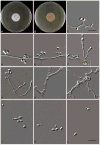Novel taxa of thermally dimorphic systemic pathogens in the Ajellomycetaceae (Onygenales)
- PMID: 28176377
- PMCID: PMC5775888
- DOI: 10.1111/myc.12601
Novel taxa of thermally dimorphic systemic pathogens in the Ajellomycetaceae (Onygenales)
Abstract
Recent discoveries of novel systemic fungal pathogens with thermally dimorphic yeast-like phases have challenged the current taxonomy of the Ajellomycetaceae, a family currently comprising the genera Blastomyces, Emmonsia, Emmonsiellopsis, Helicocarpus, Histoplasma, Lacazia and Paracoccidioides. Our morphological, phylogenetic and phylogenomic analyses demonstrated species relationships and their specific phenotypes, clarified generic boundaries and provided the first annotated genome assemblies to support the description of two new species. A new genus, Emergomyces, accommodates Emmonsia pasteuriana as type species, and the new species Emergomyces africanus, the aetiological agent of case series of disseminated infections in South Africa. Both species produce small yeast cells that bud at a narrow base at 37°C and lack adiaspores, classically associated with the genus Emmonsia. Another novel dimorphic pathogen, producing broad-based budding cells at 37°C and occurring outside North America, proved to belong to the genus Blastomyces, and is described as Blastomyces percursus.
Keywords: Ajellomycetaceae; Blastomyces; Emergomyces; Emmonsia; genomics; phylogeny.
© 2017 Blackwell Verlag GmbH.
Conflict of interest statement
None to declare.
Figures





References
-
- Untereiner WA, Scott JA, Naveau FA, Sigler L, Bachewich J, Angus A. The Ajellomycetaceae, a new family of vertebrate-associated Onygenales. Mycologia. 2004;96:812–21. - PubMed
-
- Peterson SW, Sigler L. Molecular genetic variation in Emmonsia crescens and Emmonsia parva, etiologic agents of adiaspiromycosis, and their phylogenetic relationship to Blastomyces dermatitidis (Ajellomyces dermatitidis) and other systemic fungal pathogens. J Clin Microbiol. 1998;36:2918–25. - PMC - PubMed
-
- England DM, Hochholzer L. Adiaspiromycosis: an unusual fungal infection of the lung. Report of 11 cases. Am J Surg Pathol. 1993;17:876–86. - PubMed
-
- Sigler L. Adiaspiromycosis and other infections caused by Emmonsia Species. In: Hodder A, editor. Topley & Wilson’s Microbiology and Microbial Infections. 10. London, U.K: John Wiley & Sons, Ltd; 2005. pp. 809–24.
MeSH terms
Associated data
- Actions
- Actions
- Actions
- Actions
- Actions
- Actions
- Actions
- Actions
- Actions
- Actions
- Actions
- Actions
- Actions
- Actions
- Actions
- Actions
- Actions
- Actions
- Actions
- Actions
- Actions
- Actions
- Actions
- Actions
- Actions
- Actions
- Actions
- Actions
- Actions
- Actions
- Actions
- Actions
- Actions
- Actions
- Actions
- Actions
- Actions
- Actions
- Actions
- Actions
- Actions
- Actions
Grants and funding
LinkOut - more resources
Full Text Sources
Other Literature Sources
Medical
Molecular Biology Databases

